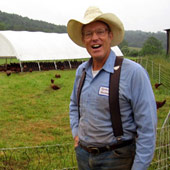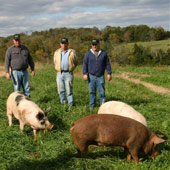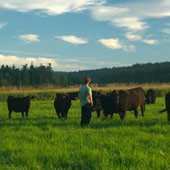-
WHAT'S IN IT FOR YOU?
When we started Let's be Frank, we wanted to support the few ranchers left in California who were raising their cattle on pasture. We were inspired and informed by a range of experts who believe that pasture-based livestock management is good for the rancher, good for the animals, good for the environment, and good for the consumer. Here is a bit of what we've learned.
-
Good for the Rancher
Joel Salatin, one of the folks you can read more about on our Heroes page, has found that pasture-based livestock management of his cattle, hogs, chickens and rabbits enables him to generate over five times the revenue per acre of land than do his neighbors, who use conventional farming methods. Joel's pasturing techniques replace costly, polluting machinery and chemicals with one of nature's most abundant products: animal manure. Salatin uses this natural fertilizer to build and maintain rich soil and good feed for his animals and plants. Instead of a backhoe, Joe lets his pigs root for food and dig up the soil. Instead of a tractor spreading fertilizer, Joe lets his chickens do the work

-
Good for the Animals
When cattle are raised in Confined Animal Feeding Operations, CAFOs, the cruelty begins with the long trip to these operations on crowded trucks, and continues with the horrible over-crowding once there. Animals are standing in their own manure, being jostled by other cattle, and need to be administered antibiotics to avoid the diseases that are rampant in these feedlots. CAFOs are designed to put a huge amount of fat on the animal and the people who run them use hormones and more antibiotics to achieve these weights. The cows are fed grain (typically grown using petroleum-based fertilizers) which causes unnatural chemical reactions in their digestive tracts, which leads to a variety of digestive disorders requiring the use of antibiotics For the sake of profit and speed, the animals are slaughtered at a rate that is twenty to fifty times faster than that at a small facility, which is extremely dangerous and often results in harm to the animals and the workers, as well as the spread of bacteria such as e-coli to other animals and ultimately, to the consumers.

-
Good for the Environment
There is an elegant relationship between cattle and pasture. Only cattle and other ruminants can turn grass into protein. The cattle have evolved to flourish on grass and to be stewards of the pastures. By fertilizing the grass with a natural and petroleum-free fertilizer, grazing cattle strengthen the pasture's root structure and enable the grass to grow stronger and greener.
Grazing animals on pasture gives more back to nature than is taken out. A well-grazed pasture can sequester more CO2 per acre than a healthy rainforest. But the biggest impact (or non-impact) on the environment is that of supplanting the need to grow corn. Again, quoting form Michael Pollan
The feedlot's ecosystem, I could see, revolves around corn. But its food chain doesn't end there, because the corn itself grows somewhere else, where it is implicated in a whole other set of ecological relationships. Growing the vast quantities of corn used to feed livestock in this country takes vast quantities of chemical fertilizer, which in turn takes vast quantities of oil -- 1.2 gallons for every bushel. So the modern feedlot is really a city floating on a sea of oil.When you eat a Let's be Frank grass-fed beef dog, you are eating sunshine in a bun. You are helping transition us from a fossil fuel-based agricultural system to a solar-powered agricultural system. Keep eating!

-
Good for You
OK, this is the kind of boring part, but for those of you who are interested in your health or the health of your children, it may be compelling. Many studies have been done on the impact of eating meat from grass-fed vs. grain fed beef.
For expectant mothers and their babies:
Doctors indicate that Omega-3 fatty acids are a vital nutritional contributor to enhanced pregnancy health.
Omega-3 fatty acids play a key part in pregnancy health, and in the healthy development of babies in the womb. The benefits of Omega-3 fatty acids are clear. To summarize recent research conclusions, Omega-3s:
- Offer critical nutrients for babies' neurological development.
- Promote the development of the fetus's cardiac and respiratory systems.
- Support the development of the fetus's brain and eyes (development of visual centers).
- Have been shown to increase the learning and cognitive functions of children, with effects measurable to age four.
- Increase the attention spans of young children (a measurable component of intelligence early in life).
- Support the pregnancy health of the mother, possibly reducing chances of toxemia (or pre-eclampsia).
- May help prevent pre-term labor and premature delivery.
Studies have shown that babies are more likely to put food in their mouths when they see a parent eat it, and toddlers, preschoolers and elementary school kids are more likely to accept foods their parents like. Food preferences are initially formed in the womb and through their mother's milk as well. The bottom line is that the best way to ensure your children eat healthy hot dogs is to eat Let's be Frank dogs yourself!
For those of us between 10 and 100:
Some of grass fed beef's benefits, in comparison with the grain-fed version, are:
- 500% more CLA (Conjugated linoleic acids)
- 400% more Vitamin A
- 300% more Vitamin E
- 75% more Omega-3 fatty acid
- 78% more Beta-Carotene
Eleven out of eleven studies to date have found that CLA decreases cancer
- Four out of five have found a decrease in body fat.
- Two out of two have found decreases in heart disease.
- Six out of six have found increased immunity to disease. Two out of two have found increased bone density. And three out of three have found a decrease in adult diabetes. While artificial CLA is now available in a pill form, natural CLA from animal products is 600% more effective in fighting cancer.
